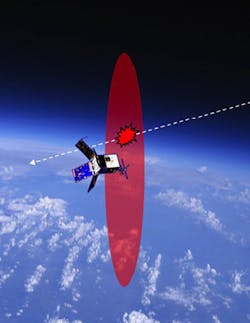Navy Develops Space-Junk Spotter
With more than 100 million pieces of debris orbiting Earth that measure less than a centimeter in diameter, researchers at the U.S. Naval Research Laboratory wanted to learn more about how such debris behaves in space. As a result, the team developed and patented the Optical Orbital Debris Spotter. The approximately 4 Ñ 4 Ñ 8-in. device weighs about 2.2 lb. and could be included on larger satellites or flown independently on nano-satellites.
The spotter uses a collimated light source, such as a low-power laser, and a conical mirror to form a sheet of light. When a piece of space debris as small as 0.01 cm intersects, some light gets scattered light. A wide-angle camera detects and records the scattered light pattern, letting the spotter calculate the intersection point and possibly the size and shape of the debris.
Over time, the information gathered would give astronomers a better idea of the density, locations, and behavior of orbiting debris. This information would greatly increase the knowledge astronomers have on space debris and could be used to build more reliable and accurate models of orbiting debris. The improved models, in turn, could then be used by agencies tracking the debris, such as the Space Surveillance Network, NASA’s Orbital Debris Engineering Model, and the European Space Agency’s Optical Ground Station.


